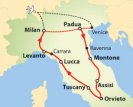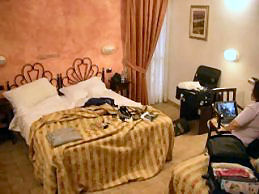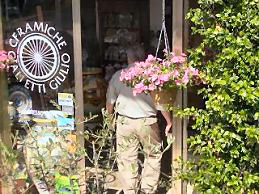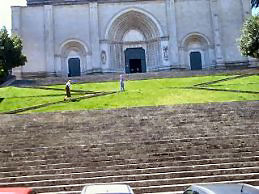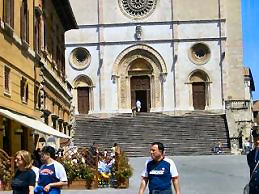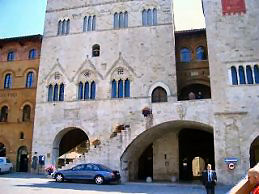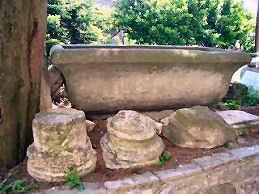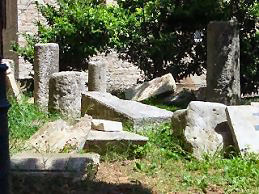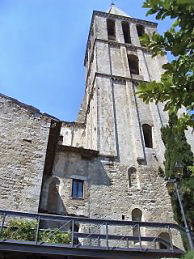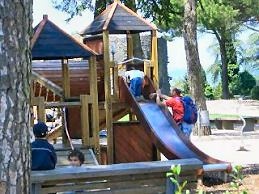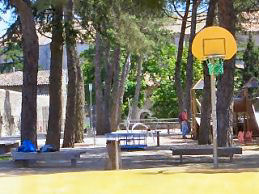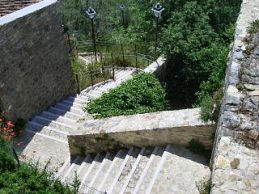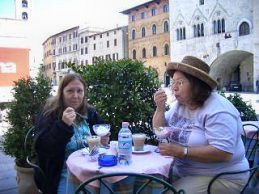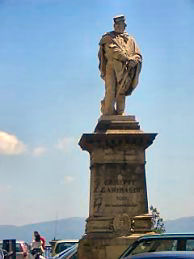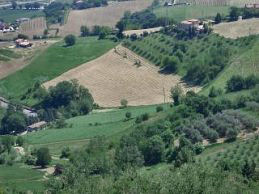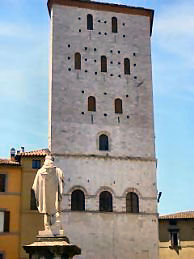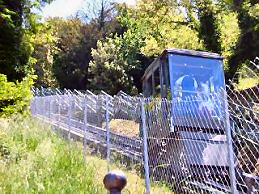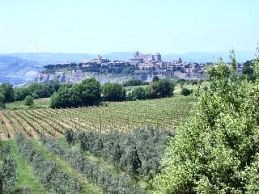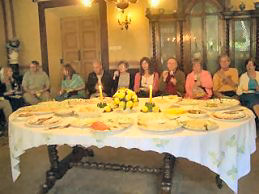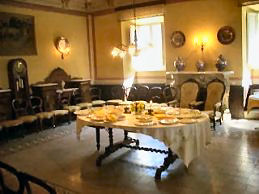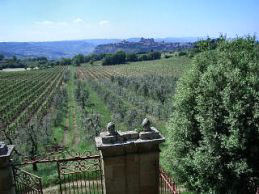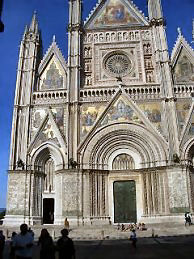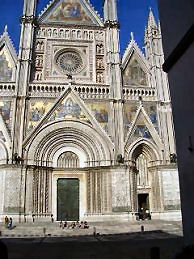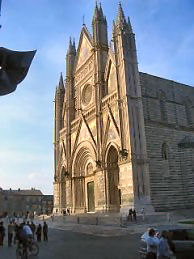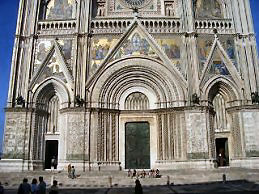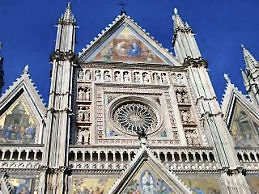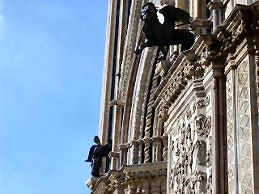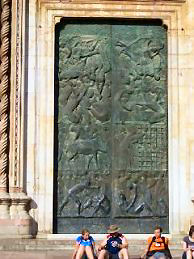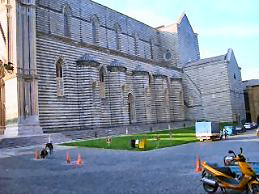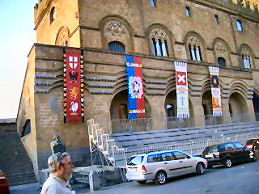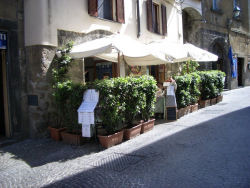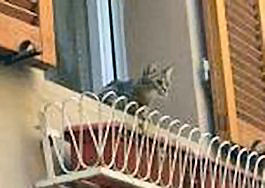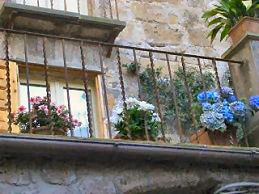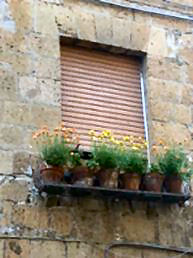Up at about five again. This seemed to be the best time of day for me to work on my journal. I got almost completely caught up. The room in Assisi had a small lamp next to the chair, so I did not have to bother Sue too much. She has always told me not to worry about putting on the overhead light, but it sure would bother me if someone did that to me while I was sleeping.
I had to lie down to rest my eyes at about 7:30. Sue had to wake me up.We were the last ones to breakfast. There were only two chairs left. I sat with Dorothy, Blaine, and Claudia. There was no milk left for the cereal. I had to load up on the usual breads and some juice. As had happened two years ago, I left Assisi with a bad taste in my mouth. Something about this town had really gotten under my skin. I did not feel that way about any other town in Italy.
We exited Assisi through the gate near the hotel. We had to walk down a long road to the parking lot. We saw the escalator. Cecile had mentioned taking an escalator on a previous trip, but she could not remember which town had it. I had no recollection whatever of taking an escalator up to Assisi in 2003. Maybe we parked somewhere else. Maybe I am just getting old.
In Deruta our bus pulled into the parking lot of a pottery place called Ceramiche Giuletti Giulio. They made and sold pottery here. We got to see a guy throwing pots and some people painting very fancy plates. We learned from Carlo, the proprietor, that they heat the pots to 1400° centigrade. The plates and pots were hand-painted in bright colors, but I couldn't work up any interest. There was no place for any of us to sit, and my hip was beginning to hurt.
At the first possible occasion I exited the store to sit in the sun. How I wished that I had brought my computer or my book or something with which to entertain myself. I walked up and down the street. Nothing but ceramic places. At one point Mario drove by in his bus. I also noticed a black guy driving a car. He was the first black person I had seen in Italy aside from tourists (very few) and street vendors (more than enough in the cities and tourist spots like the ancient church in Classe, none in the towns and villages). So far Deruta was the low point of the trip for me. I was so happy when Mario pulled back into the parking lot.
Sue and Patti were the last two to leave the ceramics store. Carlo had provided them with a huge box in which to carry whatever it was they had bought. I really did not want to know.
In the bus Nina explained that the little red houses that we had seen along the sides of the roads are case cantonieri, which have been built for people working on the roads. Most are now abandoned, but the government is trying to sell them.
I saw a billboard for a “bookmaker.” Evidently the bookies advertise in this area. Seriously. Advertisements for retailers are almost unheard of in Italy.
Next we visited Todi, which was supposedly designated the most livable town in the world by someone at the University of Kentucky. By the way, I was shocked that someone who attended college in Cincinnati could not pronounce “U.K.” correctly. Todi was a beautiful little town set (where else?) at the top of a hill. We had to take a small rectangular cable car to get from the parking lot to the town itself. Then we had a short walk to Piazza Del Popolo, the very nice central square. On the far side was a church with a large number of stone steps leading to the front door. The municipal buildings were on another side. Sue and Patti took advantage of the shade of a nearby café which sold gelato and coffee. Tom and I went off exploring.
We first dropped in at a store that sold, among lots of other things, clocks and watches. Tom had misplaced his watch at some point, and he was looking for a cheap replacement. He thought that he saw one in the window for only 9€. However, when we went inside they didn't have anything less than 15€. Tom didn't want to spend that much – he already had an alarm clock which he had been carrying in his pocket. I tried to explain to them that he wanted the one in the window. They finally explained that the one in the window was not a watch; it was a contapassi, a pedometer. On the way out of the store we looked in the window a second time. The item was clearly labeled – in English no less – a pedometer. It was manufactured by Oregon Scientific.
Tom and I decided to go up to the Parco di Rocca, the highest point in town. By hill town standards, it wasn't a long or difficult walk. We passed some ancient stone ruins (a bathtub?) and the high school. The park was very pleasant. The panoramic view was nice, but the atmosphere of the park was even nicer. Quite a few people were there – teenagers in small groups and parents with their children there taking advantage of the swing sets and jungle gyms. At the far edge of the park was a fitness course. I challenged Tom to do three pull-ups, but he demurred.
We walked back to the piazza on Via Mazzini. I explained to Tom that the three principal figures in the Italian Republican revolution were Giuseppe Mazzini the rabble-rouser, Giuseppe Garibaldi the general, and Count Camillo Benso di Cavour the politician. I said that practically every Italian city has something dedicated to at least two of the three. Sure enough, we passed Via Cavour shortly thereafter.
Sue and Patti were still at the café in the piazza. Next to the piazza was a parking lot with a fairly large statue of (who else?) Garibaldi. I walked over to check it out. Dorothy soon joined me. She said that she had been in the Roman cistern, which she told me was fascinating (but she seemed to like almost everything; I, on the other hand, was widely known as the original guastafeste / brontolone). Only a few minutes remained until the designated time to leave, 12:20. I didn't think much of it at the time. It was easy to see the meeting place from where we were.
When we assembled to go to the bus, Dorothy was nowhere to be found. I told Nina that she had been in the Piazzale Garibaldi just a few minutes earlier. Ruth Abad stayed behind to walk down with her. Ruth and Ed Mazur also volunteered to stay back.
The rest of us trooped to the cable car as a group. Only twenty people at a time could fit in the car. Ruth and the Mazurs passed a group of kids to go down in the second group. Dorothy eventually showed up (she had thought that the assembly time was 12:40), but we had to wait a few minutes for her. Nina shamed her on the bus with “Vergognati!” and the traditional finger-rubbing gesture. Fortunately she had built up enough brownie points with the pope hat that she was still in everyone's good graces.
We sat back and enjoyed the short drive to the Orvieto area. On the next hill over was our next destination, Le Velette, the home of Cecilia Bottai and her family's vineyards and winery. This was truly a fabulous place.
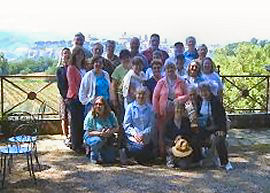
Cecilia berated Nina for being late. Dorothy volunteered that it was her fault. Another ETBD tour guide, Taunya, and her fiancé, Christof, were there. Taunya chipped in that she herself was never late. She wasn't being snide; she was just giving Nina a hard time. The estate had a terrific view of Orvieto. Cecilia took a group picture with each person's camera. Mine did not come out too well. I needed to have pressed the zoom one or two more times.
The estate has been in Cecilia's family for 200 years. The total area was about 750 acres, of which 300 are in production at any one time. The rest lie fallow.
Cecilia explained that in Italy the wife does not take the husband's name. This Cecilia seemed to me to be a force to be reckoned with. She had studied to be an interpreter. Her English was excellent. She had no hesitation about taking pictures with 20 or more cameras with no instructions or assistance. It was obvious that she ran the estate with, if not an iron fist, at last firm control. Everything was just so. She often traveled to other countries, including the United States, to promote her wines.
The wine tasting occurred in an elegant room. We sat in chairs all around the room. In the middle was a table bedecked with lots of different foods.The way that Cecilia ran the wine tasting made it a lot of fun. She let us taste four of her winery's products – two white (made from five grapes including malvasia and trebiano), one red (a tasty blend of sangiovese and cabernet), and one dessert wine which tasted like vin santo. She advised us to sample each one with the food with which it went best: light pizza with onions or zucchini, strong cheese or cheese bread, salami, and dessert. The last consisted of biscotti and a delicious “torta della nonna.” Bob was “volunteered” by the group to evaluate this wine first with salami and then with a dessert. He was adamantine that it was much better with the dessert, which was the right answer. Most people liked the third wine the best. I thought that they were all perfect for the designated food. A couple from Idaho and some people from Poland and Germany participated with us in the whole activity.
During the third course Sue dropped and broke her glass. Tom and I could finally relax, at least for a little while. Against all odds neither of us was the first one exposed as a clumsy oaf.
After the wine-tasting we went down into the cantina, in which they kept a small portion of the wine which they produced. Cecilia explained that this underground part of the estate dates back to the Etruscans – more than two thousand years. The walls are made of tufa, soft volcanic rock. Much of the wine down here is for their own consumption. You could see the roots of trees growing through the ceiling. Cecilia said that every so often they would come across a really old bottle of wine that they have forgotten about.
Christof explained to us on the bus that he was from the old East Germany. He was just about to begin his career as a Rick Steves' guide on the Best of Europe tour later in the summer.
Taunya had an unbelievable schedule for the upcoming twenty-four hours. She was planning to guide a custom tour which started in Milan on Saturday. She had to meet the party at the Malpensa Airport. She had to take the funicular railway down to the train station in the morning. Next came a train ride from Orvieto to Bologna. From there she had to transfer to a separate train bound for Il Centrale train station in Milan. The bus would then transport her to the airport, which was well north of the city. How she would meet up with the tour group was a mystery to me.
When the bus arrived at the parking lot on the outskirts of Orvieto, Taunya and Christof departed from us and walked from our bus to their lodgings in the Hotel Posta. They had complained that it was a really crummy place. They had hoped to stay in our hotel, but the Hotel Posta was the only one in which they could find accommodations. The reason for the scarcity of rooms was that this was the weekend of the Palio Dell'Oca, an annual festival and contest between two neighborhoods (two contradas each) in Orvieto. The town was full of people here for the fun. My impression was that it was the biggest event of the year in Orvieto.
We checked into the Hotel Corso, which was right on the town's main street. I carried my bags up two flights of stairs to room 15 with no pain at all. We then took a short walking tour of Orvieto. It included the duomo. They have finished working on the façade. The scaffolding was gone, and the façade was once again visible! It was nothing short of stunning. In the evening light it almost seemed to be ablaze. I took lots of pictures, but none of them did justice to the real thing. For one thing there did not seem to be any location from which I could fit the entire façade in a face-on shot.
Nina asked us how old we thought that the doors on the cathedral were. Somebody (Blaine?) had done his homework and blurted out the right answer. They were done by a Sicilian craftsman in the 1970's.
The inside of the church was much more crowded than the last time that I was in Orvieto in 2003. Nevertheless it seemed more impressive. This time I was careful to see the Pietà which I had somehow previously neglected. I don't know who carved it, but it seemed very well done to me. I didn't remember noticing the huge organ either. Jan had been walking around looking at things at eye level. She was astounded when I pointed out the pipes of the organ twenty to thirty feet overhead.
The Chapel of St. Brizio was overwhelming. Luca Signorelli's frescoes were vivid, playful, imaginative, and colorful. I remembered the paintings, but I did not associate them with Orvieto. Nina did a great job of bringing the whole process of designing this chapel to life. The scene with the Antichrist, in which Signorelli inserted his own likeness, was undoubtedly the best, but the others also seemed very good to my untrained eye. How eternal damnation as depicted in one of the frescoes compared with the conditions in the Hotel Posta was not fully resolved.
Given that the pope himself often visited or even lived in this place, it was hard for me to understand how Signorelli got away with leaving the fig leaves off of so many figures. Evidently the committee that commissioned the work was not answerable directly to Holy Mother Church. I bet that a lot of young orvietani volunteered to serve as altar boys for any function held in this chapel.
We four New Englanders took a short tour of our own after we left the duomo. We tried to eat supper at L'Asino D'Oro, a place recommended by Nina. Bob, who had made a reservation for himself, told us that it wasn't open yet when we walked by at about 7:20. We dilly-dallied around the vicinity for a while. We ventured over to see how the Piazza Del Popolo had been arranged to accommodate the Palio Dell'Oca. They had set up grandstands – maybe eight or ten rows by 50 or 60 feet. We speculated that the race or event or whatever it was probably would take place between the grandstands. The Saturday market would ordinarily be held in this plaza, but I could not see how they could set up for it with the grandstands taking up so much space.
We went back to the restaurant afterwards, but by that time we couldn't get in. We ended up at a pizza place near our hotel. I did not catch the name of the place; it was not on it's and white awning, and I did not remember seeing the name on the sign carried by a little French-looking statue. My obsession with completeness made me resolve to learn the name before we left town.
We all ordered beer alla spina and pizza. In the U.S. it would have been considered pretty good. In this country it barely qualified as pizza. Although they had hardly any patrons, they ran out of beer on tap. So they brought us bottled beer without even asking if that was OK.
Nina told us that the pope, who is after all the Bishop of Rome, has lived in Orvieto off and on when things got too hot in Rome. That and the cloak from the so-called Miracle of Bolsena (in which Christ's blood is said to have mysteriously appeared on a piece of cloth in order to help a young cleric through a crisis of faith about the transubstantiation) were the primary reasons for having such an elegant church in such an out-of the way place.
I forgot to take my ibuprofen in the afternoon. I considered it a very good sign that I could possibly forget such a thing. Moreover, it had not previously occurred to me, but my shoulder has not bothered me at all on the whole trip. Before we left on the trip I had been thinking that I had a serious problem with it, but maybe it was just related to the way I typed or used the mouse at work.
Sue loved the little terrace-porch which is between our room and the rooms of Patti and Tom and several other members of the tour. She did not come with our group on the side trip to Orvieto in 2003. She therefore decided to stay in town on Saturday. Patti agreed to stay with her. Tom and I gave them the assignment of making sure that we had dinner reservations at a decent place for a time that would allow us to make it to the Palio Dell'Oca in plenty of time. The Paliotto was scheduled to start at 9 p.m.
Note: Nina informed us that Italians almost never tip. She said that she has only tipped two or three times in eight years. This advice differs from what I have read in many guidebooks.
